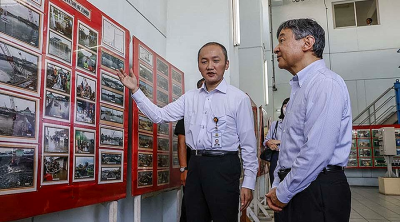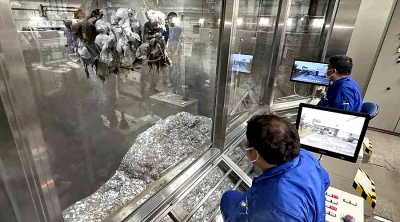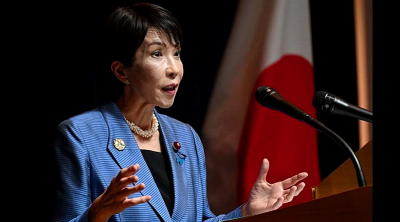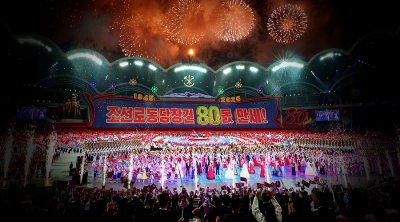
Radiation is invisible to the naked eye, but it exists all around us.
Radioactive materials are found in the ground, concrete, and even the air, although only in small amounts.
Radiation levels vary depending on the region, but in Japan the national average environmental radiation dosage is 0.05 μSv/h (microsieverts per hour).
Human beings contribute to these radiation levels, since each of us carry approximately 6,000 Bq (becquerels) of radioactive materials and emit around 6,000 radiation particles per second.
Radiation particles are naturally occurring and are referred to as environmental or natural radiation.
The impact of this environmental radiation in Japan amounts to approximately 2 mSv per year, which has no significant effect on our health.
Around the 1960s, extensive nuclear testing took place in China and other countries, resulting in the dispersion of radioactive materials into the atmosphere.
The impact of this was significant, as radioactive materials were washed down to the ground from the air in the rain.
At that time, rainwater in Tokyo contained tritium at a concentration of 200 Bq/L.
It is possible that the concentration was even higher in mainland China, located upstream of the prevailing westerlies.
This tritium concentration is not significantly different from that found in the ALPS (Advanced Liquid Processing System) treated water in Japan that is currently a topic of debate.
The tritium concentration in rainwater has been slow to decrease since the 1960s, reaching approximately 10 Bq/L in around 1970 and finally decreasing to normal values of around 1 Bq/L by 1990.
It should be noted that even today, natural radioactive materials such as radon are present in the atmosphere and can mix with rainwater, causing an increase in environmental radiation levels when it rains.
However, these levels have no significant impact on the environment.
The contaminated water stored at the Fukushima Daiichi Nuclear Power Plant following the accident of March 11, 2011 has been treated to remove hazardous substances using the aforementioned ALPS.
Since tritium cannot be removed from this ALPS-treated water, the plan is to dilute the water with a large amount of seawater before releasing it one kilometer off the coast via an undersea tunnel.
ALPS-treated water undergoes prior analysis to ensure its safety before being released. The risks claimed by China and elsewhere do not exist scientifically.
Two concerns have been raised about the release of this ALPS-treated water. First, that dangerous radioactive substances may still be present in the water and, second, that the tritium known to remain in the water may have an impact on the environment.
Firstly, ALPS efficiently removes dangerous radioactive materials from contaminated water. If these materials are not completely removed in one treatment, the process is repeated a second time to ensure their thorough removal.
Furthermore, by the time of the release of ALPS-treated water, three independent organizations will have spent over two months closely analyzing the quantity of radioactive materials contained in the treated water.
The analysis results are continually published online, and the data published so far all align within the acceptable range of error.
It has been confirmed that the treated water contains negligible amounts of dangerous substances, and even if there are trace amounts, they are well below international standards.
Regarding the tritium that cannot be removed from the water, dilution with a large amount of seawater will reduce the concentration (1,500 Bq/L or less) to well below international standards (10,000 Bq/L or less) even before the water is released offshore.
It might be noted that tritium is managed and released into the ocean from nuclear power plants in countries such as China and South Korea using a similar process.
The oceanic release of ALPS-treated water will be scientifically identical to the tritium oceanic releases conducted by China, South Korea and others, and the total amount will in fact be lower than that released by China and South Korea every year. There will be no environmental impact from the tritium released.
Following the release of ALPS-treated water, monitoring will be enhanced and thorough safety checks will be conducted in numerous locations, with a focus on the discharge area.
If any abnormalities are detected in the monitored radiation levels, the release will be immediately halted.
In other words, any environmental impact would be effectively managed and swiftly controlled.
Currently, China and other countries are baselessly spreading news that ALPS-treated water is dangerous.
ALPS-treated water undergoes prior analysis to ensure its safety before being released, and monitoring is also strengthened.
The risks claimed by China and elsewhere do not exist scientifically.
As mentioned earlier, environmental radiation levels increase when it rains. However, the amount of radiation is extremely small and has no significant impact.
The impact of ALPS-treated water is even smaller than the increase in environmental radiation due to rain.
Anyone concerned about the effects of ALPS-treated water should also be careful not to get wet in the rain. Radiation is already present all around us.
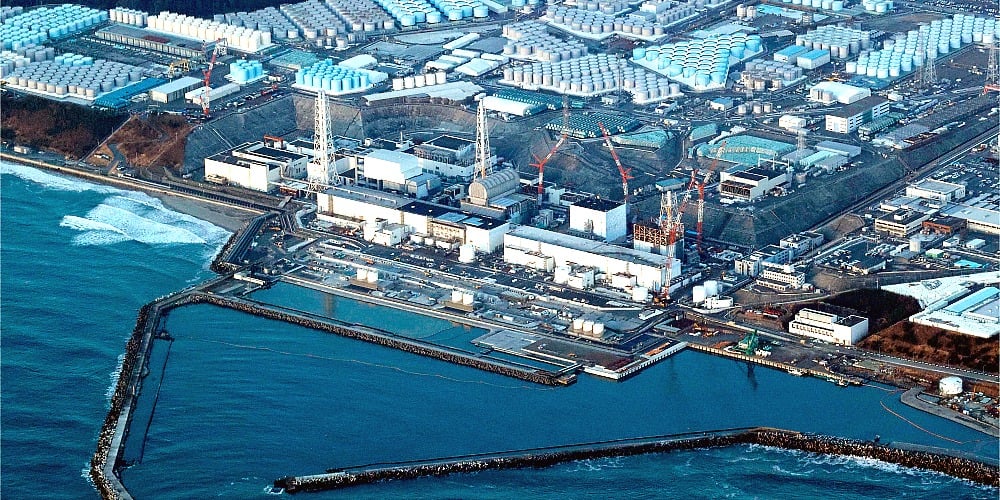
Read also:
- Fallout from Fukushima radioactive wastewater
- Letter to the Editor from the Embassy of Japan on the release of ALPS-treated water
- Another scenario for Fukushima wastewater problem
- Radiation is all around us: On the safety of Japan’s release of ALPS-treated water
- Countering concerns about the release of ALPS-treated water
(Koji Okamoto is Professor at the University of Tokyo, Japan.)
ADVERTISEMENT
ADVERTISEMENT







